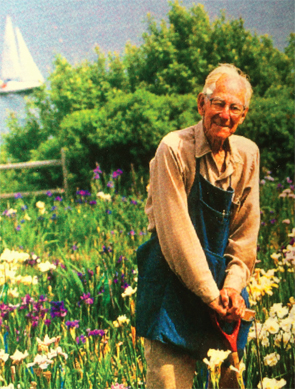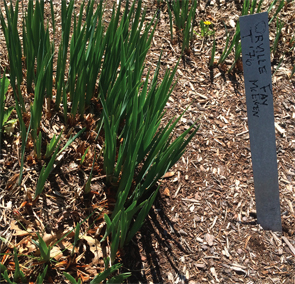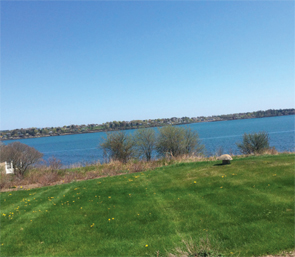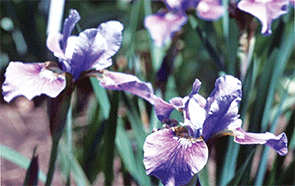
Dr. McEwen tending his garden
Currier McEwen, MD, was a truly remarkable rheumatologist, accomplishing more than even the best of us could imagine. He is even more recognized in the horticulture community as a hybridizer of flowers.
He was born Osceola Currier McEwen on April Fool’s Day, 1902, in Newark, N.J., and died in 2003, at the age of 101. Named after his father, he chose to go by Currier.
His Career
After graduating magna cum laude and Phi Beta Kappa from Wesleyan University, he enrolled in New York University (NYU) School of Medicine. He trained in internal medicine at Bellevue Hospital, then spent four years at the Rockefeller Institute for Medical Research, before joining the NYU medical faculty at the age of 30.
 Dr. McEwen established the Rheumatic Disease Study Group at NYU, perhaps motivated by the fact that his father was so crippled by psoriatic arthritis that his pediatric patients had to be carried to him and placed in his lap. By age 35, Dr. McEwen had become dean of the School of Medicine, where he was instrumental in creating the NYU Medical Center.
Dr. McEwen established the Rheumatic Disease Study Group at NYU, perhaps motivated by the fact that his father was so crippled by psoriatic arthritis that his pediatric patients had to be carried to him and placed in his lap. By age 35, Dr. McEwen had become dean of the School of Medicine, where he was instrumental in creating the NYU Medical Center.
His career in our professional organizations was no less stellar. He was a founding member of the American Association for the Study and Control of Rheumatic Diseases, and served on its Executive Committee from 1939–60. He was president of the American Rheumatism Association in 1952–53, and was recognized as a Master of the American College of Rheumatology in 1987.
He left NYU for Harpswell on the southern coast of Maine in 1970 at the age of 68, because he considered it “the best place in the world,” having summered there since childhood. He served as consultant at the Mid-Coast Hospital in Brunswick, Maine. From this base, he traveled two-week circuits, visiting hospitals in far northern and eastern Maine, which had no rheumatologists, until younger colleagues

The site of Dr. McEwen’s garden in Harpswell, Maine, now tended by Sharon Whitney (Eartheart Gardens) who for many years worked closely with Dr. McEwen in his hybridization efforts
took over this role in the 1980s. He finally retired from medicine at the age of 82, but helped describe a family with early-onset osteoarthritis at the age of 92.
More than Medicine
One of us [KF] knew of Dr. McEwen primarily from his eminence in the horticultural world as a hybridizer of iris. But he did not wait until medical retirement to launch this endeavor. He joined the American Iris Society in 1956, and in 1960, while attending a medical meeting in Chicago, he met Orville Fay, who had developed the technique of using colchicine to induce tetraploidy in daylilies.
Most plants are diploid (their somatic cells contain two copies of each chromosome), although polyploidy naturally occurs in such plants as alfalfa, cotton, potatoes and wheat. Dr. McEwen chose to attempt to develop tetraploid versions of the “beardless iris,” which differs from its “bearded” relative by having smaller flowers and foliage, which is attractive throughout the growing season. By incubating the seeds in a colchicine solution, he created tetraploids:
“When a sprouting seedling … is treated with a solution of colchicine, the process of cell division (mitosis) … is interrupted. During mitosis the chromosome sets double. Normally the sets then move apart to opposite sides of the cell in preparation for cell division. Colchicine inhibits that movement. Cell division stops but not before the chromosomes have doubled. In an attempt to be ‘concise,’ one could say that the cells are ‘stuck with the double set of chromosomes.” This quotation comes from The Siberian Iris, written by Dr. McEwen and illustrated by Jean G. Witt, which has been the definitive book it its field since its publication in 1996.
The challenge was to create stable tetraploid hybrids, which would grow back as tetraploids year after year. To investigate this, Dr. McEwen examined the pollen of the new flowers under a microscope in a primitive hut in his garden. He successfully developed the first two tetraploid Siberian Iris cultivars, with deeper color, larger flowers, stronger stems and wide leaves. He named the first, Orville Fay, after his colchicine mentor, and another, Harpswell Snowburst, after his beloved Maine village. He also applied this technique to developing tetraploid Japanese Iris cultivars.
To fully understand the magnitude of his success, consider the list of awards Dr. McEwen received for his horticultural efforts:
- Hybridizer’s Medal of the American Iris Society, 1976
- Foster Memorial Medal of the British Iris Society, 1977
- Distinguished Service Medal of the Perennial Plant Association, 1991
- Payne Medal (for Japanese Iris), 1992 and 1993
- American Iris Society Gold Medal, 1999
Legacy

Examples of the Orville Fay that Dr. McEwen developed.
By all accounts of those who knew him, despite his exceptional talents, Dr. McEwen was a modest, gentle, kind man who did not draw attention to himself. As he aged, he continued to garden, with the assistance of a walker, which he modified to hold his garden shears and shovel. In 2002, he was recognized at a 100th-year celebration of his birth in Harpswell.
Dr. Currier McEwen passed away on June 23, 2003, after a hip fracture. He died in the Brunswick hospital at which he had served as a consultant 32 years previously.
His legacy as a hybridizer of irises lives on. The Siberian Iris and The Japanese Iris (also by Dr. McEwen) are in every iris gardener’s library. The Japanese Pinwheel is one of the most popular Japanese irises ever created. His original garden in Harpswell is lovingly maintained by a protégé, and displays more than a hundred of his creations.
We have had several species of Currier McEwen iris in our garden for years. We plan to plant the Orville Fay this year, as a special homage to Dr. McEwen and his colchicine mentor.
Kathleen Ferrell, PT, MLA, is a physical therapist and former president of the ARHP. She is an emeritus member of the national Arthritis Foundation Board of Trustees and a member of the Missouri Arthritis Advisory Board. She is also a Master Gardener with the Missouri Botanical Garden, and former president of the St. Louis Herb Society.
Rick Brasington, MD, is a rheumatologist and fellowship program director at Washington University in St. Louis, and an associate editor of The Rheumatologist.
Acknowledgments
Thanks to Sid and Martha Block, who shared stories and photos of their friend, Currier. Special thanks also to Sharon Whitney of Earthart Gardens in Harpswell, who gave us a tour of Dr. McEwen’s original gardens.


